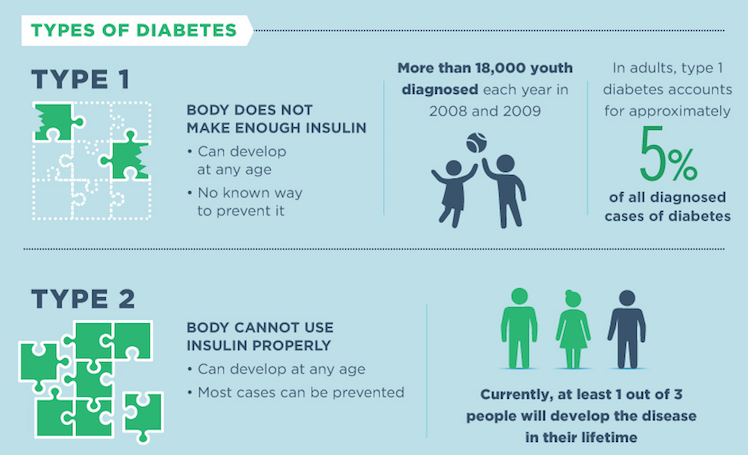Diabetes is a group of metabolic diseases characterized by high levels of blood glucose (hyperglycemia). The two main types of diabetes–type 1 and type 2–differ in terms of cause, typical age of onset, and prevalence. People with diabetes typically experience the following symptoms:
- frequent urination
- increased thirst
- hunger
- extreme fatigue
- blurred vision
- wounds that are slow to heal
- unplanned weight loss
- pain or numbness in feet or legs
Type 1 Diabetes
Although type 1 diabetes can occur at any age, it is most diagnosed in children and adolescents. Type 1 diabetes was previously called juvenile-onset diabetes. 5% of people with diabetes have type 1 diabetes.
The body of people with type 1 diabetes is not able to normally produce insulin, which is a hormone that is produced by the beta cells of the pancreas and signals the need to break down glucose in the blood. Without an adequate amount of insulin, glucose accumulates in the bloodstream instead of being supplied to the various cells in the body for energy consumption.
Type 1 diabetes is a chronic disease that can be managed by insulin injection, blood glucose control, exercise, and nutrition. There is no known way to prevent type 1 diabetes.
Type 2 Diabetes
Type 2 diabetes typically develops later than type 1 diabetes and therefore was previously called adult-onset diabetes. This form of diabetes account for about 95% of diagnosed cases of diabetes in adults.
In type 2 diabetes, the body experiences insulin resistance, when the muscle, liver, and fat cells do not respond to insulin properly. At first,the beta cells in the pancreas compensating by making extra insulin; however, over time the pancreas gradually loses the ability to produce sufficient levels of insulin to maintain a normal level of blood glucose. As a result, a high level of glucose builds up in the blood, and the body cannot properly use glucose for energy.
Risk factors for developing type 2 diabetes include family history of diabetes, older age, physical inactivity, obesity, and race/ethnicity. Type 2 diabetes are more common in African Americans, Hispanics/Latinos, American Indians, some Asians, and Native Hawaiians or other Pacific Islanders.
Physical exercises and healthy diet are important components of the treatment and management of type 2 diabetes. Medications may also be prescribed to help with maintaining normal blood glucose levels.
Prediabetes
Prediabetes is the condition when one’s blood sugar level is higher than normal but is not yet high enough to be diagnosed with diabetes. Although some risk factors, such as age and family history, may predispose a person to developing diabetes, lifestyle changes can help with preventing or delaying the onset of type 2 diabetes.
Take a prediabetes risk test to find out if you may have prediabetes
